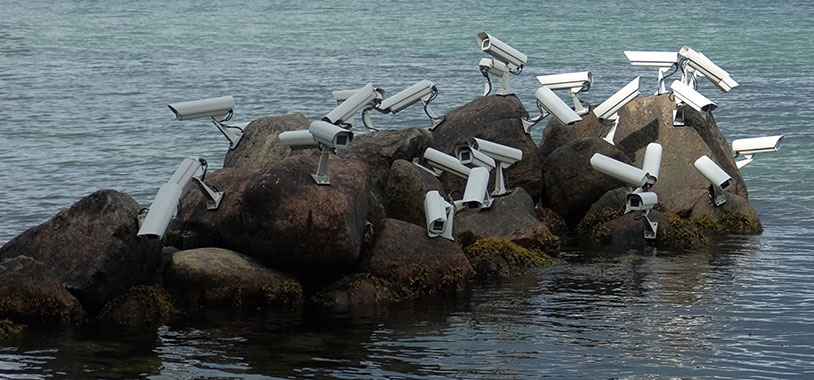

The operational requirement for what you want to get out of your system should be reflected in the technical capacity of the technology systems that you put into your site, but also in the human factors approach that you take to ensuring that people can deliver on the technology potential.
One of the things that I have noted a number of times in the past is how the visual interface presented to operators compromises their detection ability. This relates to the number of monitors, number of camera views, size of camera picture display, which cameras are displayed, and multiple camera views displayed on monitors.
Of all of these factors, the most critical issue is the display size of a camera view to an operator, whether on a single monitor or, in the case of multiple camera views, displayed on a single large screen. From a technical point of view, the objective often seems to be to display as many camera views as possible, even if they have to be a small size on the display. From my earliest involvement in the industry, this has been the factor most likely to restrict the potential performance of the system because operators simply are physically unable to see the necessary behaviour or conditions that tell them an incident is occurring. It means that the human factor interface of cameras is simply incapable of allowing the operators to do their job properly.
The resolution required to do the job
The UK Home Office, in its initial CCTV technical and human operational recommendations in 1994, highlighted the need to define the purpose of observing each area for a camera. These guidelines were a response to the poor performance nationally in the early implementation of CCTV sites in the 1990s, despite the huge amounts of money dedicated to CCTV by the UK government. The original operations requirements manual by Jim Aldridge was an attempt to professionalise implementation of CCTV systems and the approach had a major positive impact in improving system implementation in the UK and elsewhere.
The document provided for four main purposes of a camera. The first was ‘monitoring’ of the speed and movement of a person with the expectation that the person should take up at least 5% of the screen size in order to do this effectively. The second purpose of a camera was to be able to ‘detect’ a person in an area effectively, with the person taking up a screen size of not less than 10% being seen as the requirement in order to do this effectively.
The third area was ‘recognition’ or the image required to recognise a known person, with the person taking up not less than 50% of the screen size. The fourth purpose was to use the camera for the clear and unambiguous ‘identification’ of a person through displaying 120% or more of the person on screen, which would equate to waist to head. This was seen to facilitate the positive identification of a person for legal purposes and although the recommendation for identification was changed to 100% in later manual editions, town centre operations mostly maintained the 120% as best practice.
The later edition of the operational recommendations also had a greater focus on the types of issues being looked at. However, there was also a fifth purpose stated in the original 1994 manual, that of ‘Other, specify’, which I’ll discuss briefly below. For all of these purposes though, the intention was to have the camera image of the person displayed on a standard monitor being viewed by an operator. Having a postcard size camera view with detection displayed with 15 or 23 other camera views on a large screen, in contrast to say a full screen view on a 15-inch monitor, completely ignores the purpose as defined in the requirements – it literally becomes impossible to ‘detect’.
The fifth element
If we look at the behavioural analysis for the detection of a range of crimes, the need to see specific behaviours moves into the fifth ‘specify’ category. However, the type of behaviour is going to be dependent on the purpose of the camera being installed. Movement behaviour around an area may not require close monitoring and the image of the person can be displayed relatively small on screen.
Personal behaviour, however, may include specific hand movements, head or shoulder positions, anxiety responses such as touching the face, etc. For these, a much larger image of the person needs to be displayed on screen. For more subtle behaviour such as expressions, eye movement and hand behaviour, the images may be comparable to the 120% view on a standard monitor. In order to see microfacial expressions, even closer views may be required.
It is not enough to display a CCTV camera view, it is necessary to display it meaningfully. This means that the correct size image of the person on camera, as well as the way the camera view is displayed in the control room in order to allow you to see the required behaviour are necessary. These are probably the two most common points internationally where CCTV systems become compromised. Despite technical and physical limitation, managers often expect the operators to perform and detect the almost impossible-to-see behaviour.
A colleague, Rob Anderson, came up with the idea of having a ‘job description’ for each camera some time ago. This concept is useful to define what the camera is expected to see, much in line with the operational requirements. Further to this then, is how the expected behaviour is displayed on the monitor in the control room. Different types of crime behaviour may need to have camera views and displays aligned with the area in which they occur, or the most optimal display in the event of a range of crime incidents potentially occurring.
You can’t manage what you can’t see
When conducting human factor audits, this is one of the key things we do to examine the system capability. For the user though, first off they need to determine what kinds of crime and associated behaviour they are expecting to see in the camera view. Secondly, does the camera view capture such behaviour in the designated area? Thirdly, on the camera view in the control room, if you sit down in the seat of the operator, can you see the expected behaviour in the camera image being displayed on the monitor? If necessary, acted out incidents of the type being looked for can be rehearsed in the area.
If the camera view displayed is physically too small to see the behaviour, you need to adjust the way camera views are shown in the control room. If the control room manager or company manager cannot see the behaviour, then how can they expect the operator to see it? Every control room should have this kind of practical test implemented for the way control room monitors display the camera views – it’s one of the first things I do when I walk into a control room.
Perhaps the most limiting aspect of this approach is that one needs to have a good idea of the behavioural indicators that occur for a range of different types of crime, and people are not always clear about these. However, the whole point is not to have as many cameras displayed on your screens as technologically possible, but to display the information produced as effectively as possible.
I have previously emphasised the importance of camera display management where the most important cameras are displayed at the most important times, which lets you cut down on camera views being displayed. The existing views then need to be displayed in a way that lets you see the critical behaviour of an incident. With all the technology advancements since 1994’s first publishing of the operational requirements manual, it is disappointing that the simple matter of physically displaying a specified camera view in the control room is still the greatest limitation to effectiveness of CCTV.
About Dr Craig Donald

Dr Craig Donald is a human factors specialist in security and CCTV. He is a director of Leaderware which provides instruments for the selection of CCTV operators, X-ray screeners and other security personnel in major operations around the world. He also runs CCTV Surveillance Skills and Body Language, and Advanced Surveillance Body Language courses for CCTV operators, supervisors and managers internationally, and consults on CCTV management. He can be contacted on
| Tel: | +27 11 787 7811 |
| Email: | [email protected] |
| www: | www.leaderware.com |
| Articles: | More information and articles about Leaderware |

© Technews Publishing (Pty) Ltd. | All Rights Reserved.